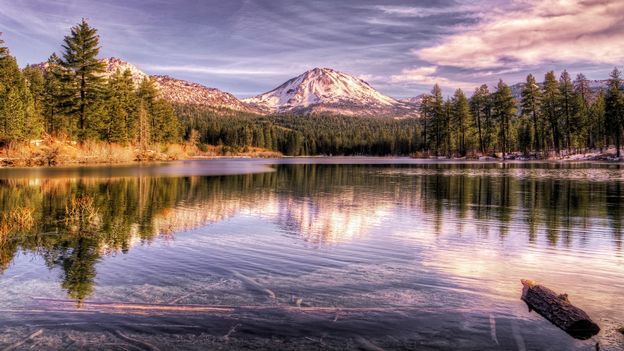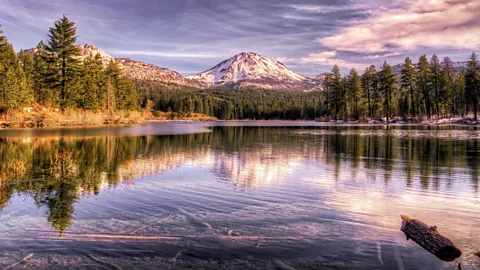Travel
Lassen Volcanic National Park: California’s spectacular alternative to Yosemite

 Getty Images
Getty ImagesYosemite may get all the attention, but a road trip to Lassen’s otherworldly landscape offers a hit of jaw-dropping natural beauty – without the crowds.
If Yosemite is the Disneyworld of California’s national parks, Lassen Volcanic National Park is the county fair. But despite hosting just 11% of Yosemite’s annual visitors to its otherworldly landscape, Lassen is no less awe-inspiring, yet its remote location and shorter season all help keep the crowds away.
“People don’t quite know what’s here other than a large volcano,” said Lassen park ranger Shanda Ochs, referring to Lassen Peak, the world’s largest plug dome volcano that famously spewed ash 200 miles across California in 1915 and brought the area to the world’s attention. But once visitors leave, Ochs says they tell her how surprised they were by Lassen’s brilliant blue alpine lakes, dense conifer forests, wildflower meadows and surreal geothermal features such as steaming fumaroles and boiling mudpots heated by magma three miles underground.
Today, Lassen remains an active volcano, but scientists say it’s highly unlikely that it or neighbouring Mount Shasta will erupt in the next 30 years. Instead, its spewing volcanic gasses and belching pools evoke an eerily beautiful Martian-esque world, and a reminder that California remains a rumbling, bubbling volcanic land in the making. As my family and I discovered, Lassen also makes for a spectacular summer road trip – especially when you combine it with a few other natural wonders nearby.
My husband and our two boys started our trip by driving 160 miles north of Sacramento to Redding, the closest major city to Lassen, located roughly an hour’s drive from the park entrance and home to the iconic Sundial Bridge.
Planning your trip
Lassen’s high elevation means there is snow is on the ground and the park’s main road is often closed until the summer. According to Ochs, July through September is the best time to visit, to ensure that you can see most of its main sites.
Opened in 2004, the bridge was designed by famed Spanish architect Santiago Calatrava and is an engineering marvel. It’s paved with translucent blue glass that glows aquamarine at night and is supported on the opposite end with a curved 21-storey pylon that, thanks to its north-south orientation, makes it one of the world’s largest sundials. As I stood in the centre of the 710ft-long pedestrian bridge, watching the fishing boats trolling for salmon and trout in the Sacramento River below, I couldn’t help but be impressed.
The following day, we headed 20 miles north to check another natural wonder off our list: Shasta Caverns, a private network of limestone caves dating back 200 million years located 900ft above Shasta Lake, California’s largest reservoir.
After a ticketed pontoon boat ride across the lake and a short shuttle ride up the steep mountain, we arrived at the cave’s entrance, where there was a breathtaking view of Mount Shasta and the shimmering blue lake below. Inside, a lighted light trail wound past stalactites, stalagmites, soda straws and 16 other different kinds of cave formations, as well as fossilised flora and fauna dating back 270 million years.
Before heading out to Lassen, we made a short stop at a beloved national landmark: Burney Falls. The 129ft-tall waterfall crashes into a wide mist-filled basin and was considered sacred by the Pit River Native Americans who once resided here. Former US president Teddy Roosevelt even called it the “eighth wonder of the world” because of its many levels of cascading streams. Today, Burney is so well-loved by tourists that the parks department recently had to close the trail leading to the base of the falls to repair erosion from all the foot traffic. The trail is expected to reopen after the summer tourist season, so if it’s closed, head 30 minutes south to see another dramatic volcanic feature located near Lassen’s northern entrance: the Subway Cave, a 1,300ft-long lava tube cave created by lava that cooled on top of a hot rushing flow located near Lassen’s north-western entrance.
Tip:
There are just a few small villages, such as Mineral, leading to the park’s two entrances and few food options, so be sure to pack food before getting to the park.
Once inside the park, it’s a short hike to Manzanita Lake. The area is popular with campers, and you can rent kayaks and stand-up paddleboards to explore the wooded lake. But with limited time to explore the park, we opted instead to hike around Lassen’s geothermal features and other alpine lakes.
The two most popular hikes in the park are the strenuous Lassen Peak hike, a switchback trail that gains almost 2,000ft in elevation and affords panoramic views at the top; and Bumpass Hell, a relatively easy three-mile roundtrip hike where you can walk on a boardwalk through a scorched-earth landscape of bubbling geothermal features, including Big Boiler, one of the hottest fumaroles in the world with temperatures as high as 322F.
Rangers advise that hikers stay on the boardwalk, as the ground (which looks solid) is often a fragile crust of dirt concealing boiling water and mud underneath. The site’s name is a cautionary tale, coined after cowboy Kendall Bumpass who stumbled upon these boiling pots in the 1860s, breaking through the dirt and burning his leg so badly he lost it. Non-hikers can also enjoy a peek at these steaming, roiling, geothermal features at Sulphur Works, accessible via the paved highway just outside the Kohm Yah-mah-nee Visitor Center.
Beyond the volcano, Lassen has a more verdant side. The King’s Creek Meadow, with its winding stream and yellow wildflowers, reminded me of the alpine setting of the Sound of Music. And save time for the crystalline blue Emerald Lake, which is less crowded than Manzanita, as well as the view of Lassen Peak from the highest point on the park road (8,512ft).
Also worth a look is Lassen’s Devastated Area, an aptly named volcano-scarred expanse that has been repopulated with conifers. A half-mile drivable loop with markers tells the story of how this part of the park recovered following the 1915 blast and became forest land again.
Without huge park lodges or a wealth of amenities, Lassen is refreshingly uncrowded. For us, that meant few selfie-snapping crowds, even during its peak season last August. Its smaller size also means you can see most of Lassen’s most striking sites in two or three days, according to Kevin Wilsey, who owns the nearby Highlands Ranch Resort, which is set in a beautiful meadow a few minutes outside Lassen’s south gate in Mill Creek.
“It’s an absolutely stunning park to go to,” said Wilsey. “We used to sneak over here [to what is now the lodge] and say we were going to buy this one of days. It’s beautiful, and I’m happy to be the steward.”
The Open Road is a celebration of the world’s most remarkable highways and byways, and a reminder that some of the greatest travel adventures happen via wheels.









